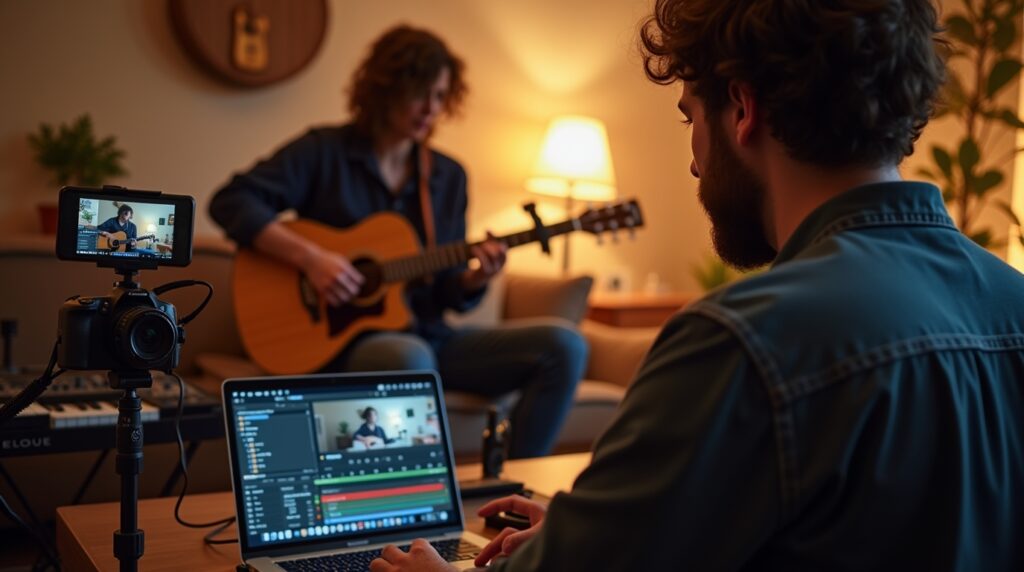If you’re a musician who streams live performances, learning how to record and reuse your live music streams can multiply your content and grow your audience on platforms like YouTube, TikTok, and Instagram. In this guide, we’ll show you exactly how to capture, edit, and repurpose your streams to get the most out of every performance.
What Does It Mean to Reuse a Live Stream?
Reusing a live stream means taking your original performance—recorded while live—and repackaging it for other platforms or content types. This can include:
- Full replays on YouTube
- Highlight clips for social media
- Audio-only versions for Spotify or podcasts
- BTS (behind-the-scenes) content or bloopers
- Live album recordings
It’s a smart way to extend your reach and grow your music brand beyond the live moment.
📄 When reusing streams, don’t forget accessibility. Adding captions and audio options ensures your VODs reach more viewers.
Why Should Musicians Record and Repurpose Live Streams?
- 🎯 Reach more people across multiple platforms
- 📈 Grow your fanbase even after the live show ends
- 💰 Create new income streams from YouTube ads or Patreon
- 🧠 Save time by turning one performance into many pieces of content
- 🎵 Use performances for future releases, promos, or EPKs
Tools You’ll Need to Record a Live Music Stream
📹 Recording Software or Hardware
- OBS Studio (Free): Built-in recording option with customizable quality
- Streamlabs: Auto-record feature plus cloud backup (paid plan)
- Ecamm Live: High-quality local recording for Mac users
- Hardware Recorders (e.g. ATOMOS Ninja V): Pro-level HDMI recorders
🎛️ Audio Interface
Make sure you’re recording clean audio directly from your interface or mixer—not just your stream’s compressed output.
🗂️ Storage
Use an external SSD or high-capacity drive to store raw recordings. Streaming + recording simultaneously can fill up space fast.
How to Record Your Live Music Stream (Step-by-Step)
1. Set Up OBS or Streaming Software
- Open OBS Studio
- Go to Settings > Output > Recording
- Choose recording format (MP4 recommended) and quality
- Set your save path (external drive if possible)
2. Use Separate Audio Mixes (Optional but Ideal)
- One mix for the stream (compressed, processed)
- One mix for recording (clean or high-quality master)
You can route audio using software like Loopback, VoiceMeeter, or your DAW.
3. Press Record Before You Go Live
- Hit “Start Recording” in OBS before “Start Streaming”
- Always do a quick test to ensure everything is working and synced
4. After the Stream Ends
- Stop recording manually in OBS
- Back up your file immediately to the cloud or another drive
- Optional: Normalize and process audio in a DAW like Logic, Reaper, or Ableton
How to Reuse Your Recorded Stream
| Repurpose Type | Platform | Notes |
|---|---|---|
| Full Replay | YouTube, Facebook | Edit start/end, add intro/outro |
| Short Clips | TikTok, Reels | Use vertical format, highlight key moments |
| Audio Podcast | Spotify, Apple | Extract and normalize audio in DAW |
| Live Album Track | Bandcamp, Patreon | Mix & master the best live takes |
| Behind-the-Scenes | Instagram Stories | Share fun moments, gear shots, outtakes |
Pro Tips for High-Quality Recordings
- 🎙️ Record isolated audio tracks (multitrack if possible)
- 🎬 Use a higher bitrate for recording than for streaming
- 🎛️ Avoid clipping or compression on the recording mix
- 🧼 Clean up background noise in post
- 🎨 Add branded intros/outros for YouTube uploads
FAQ
Yes, but quality is limited. Use OBS to locally record a high-quality version.
No, OBS doesn’t support editing. Use software like DaVinci Resolve, Final Cut, or Premiere Pro.
Yes—especially if you’re uploading to YouTube or monetizing. Consider music licensing options.
Final Thoughts
Learning how to record and reuse your live music streams is one of the best ways to grow your music brand without extra work. With the right tools and a bit of planning, you can turn every performance into a long-term asset across platforms.
